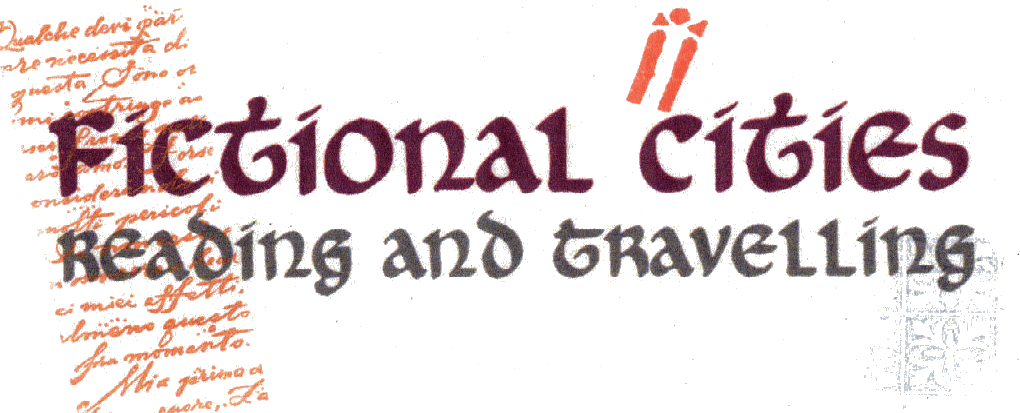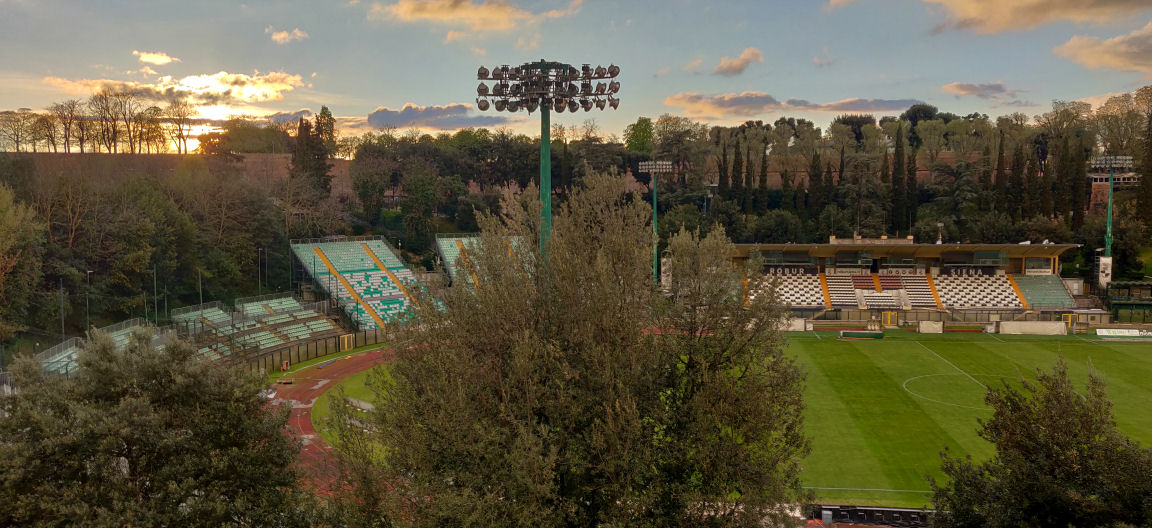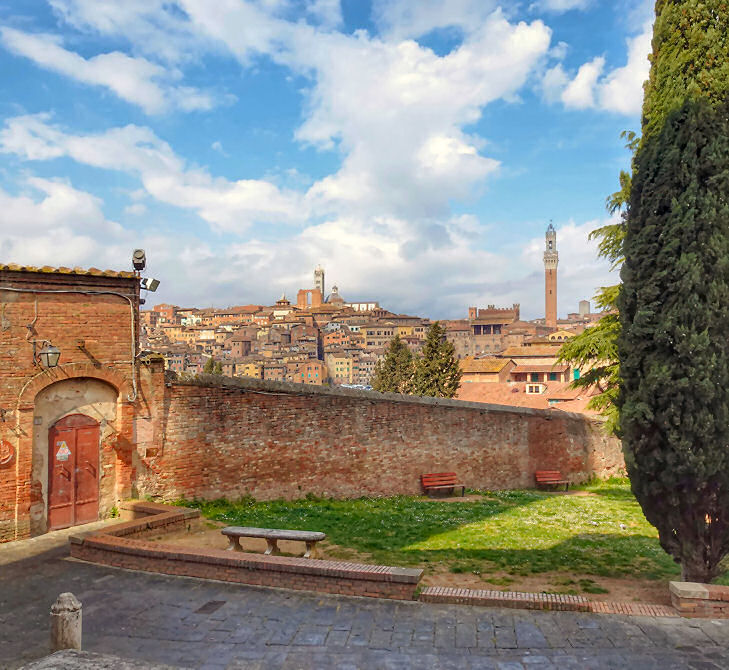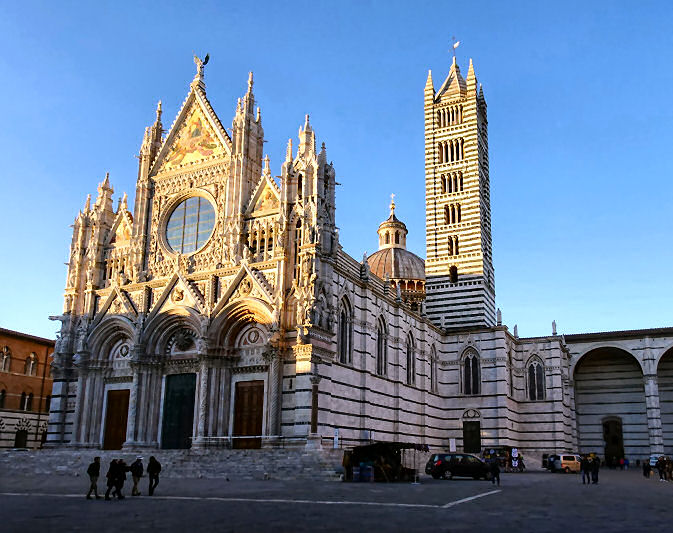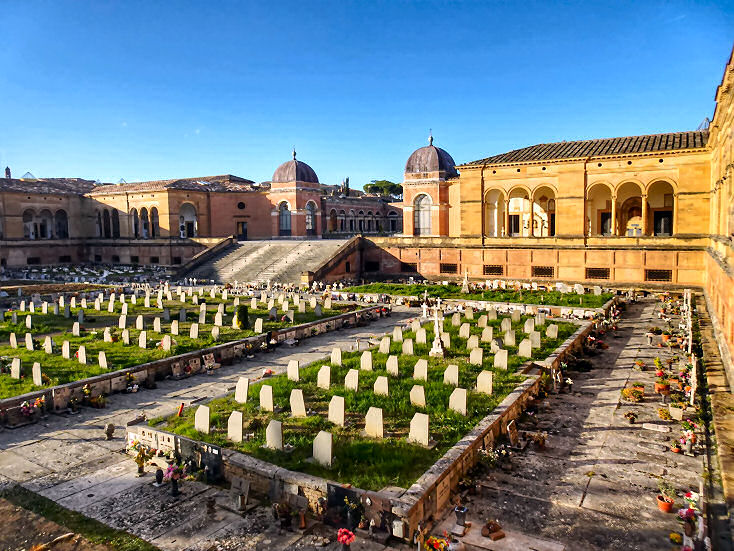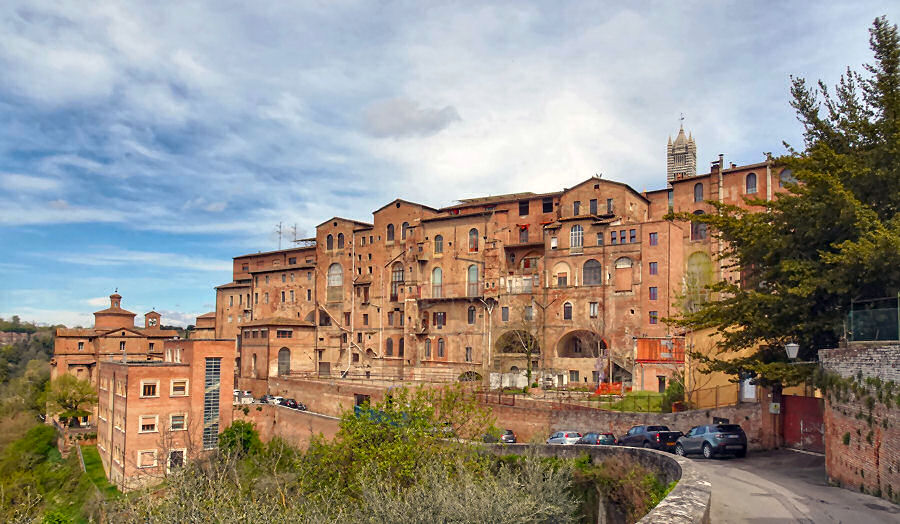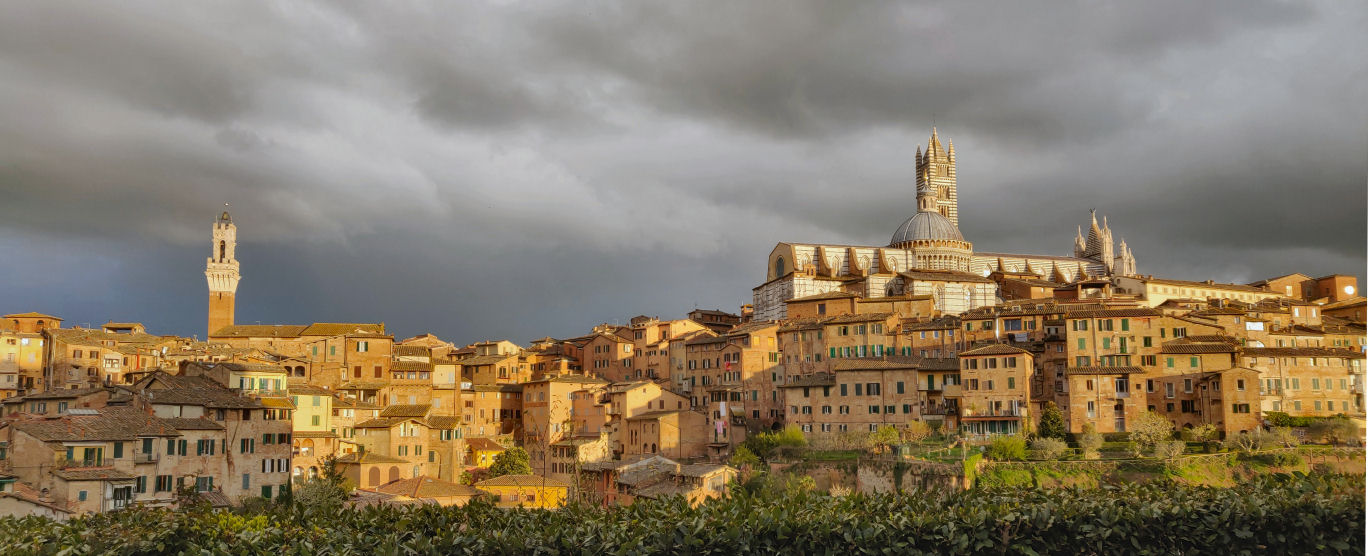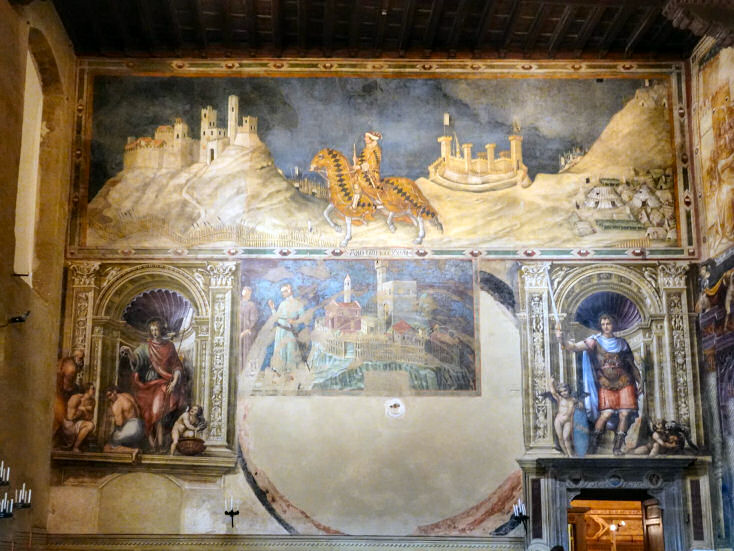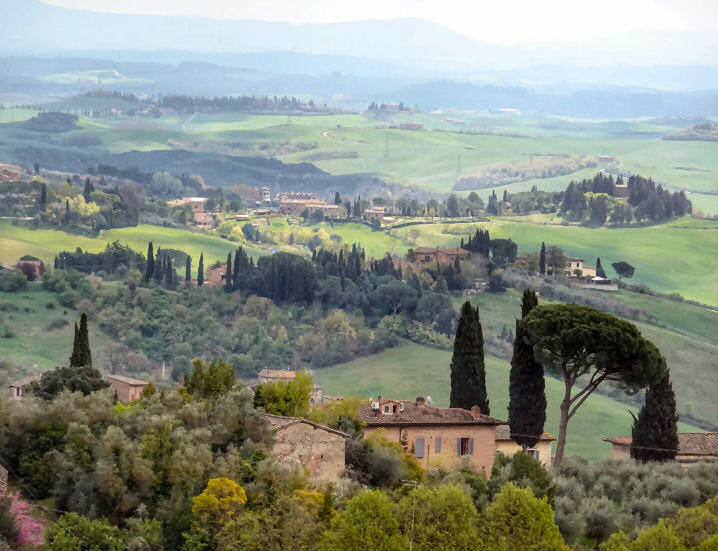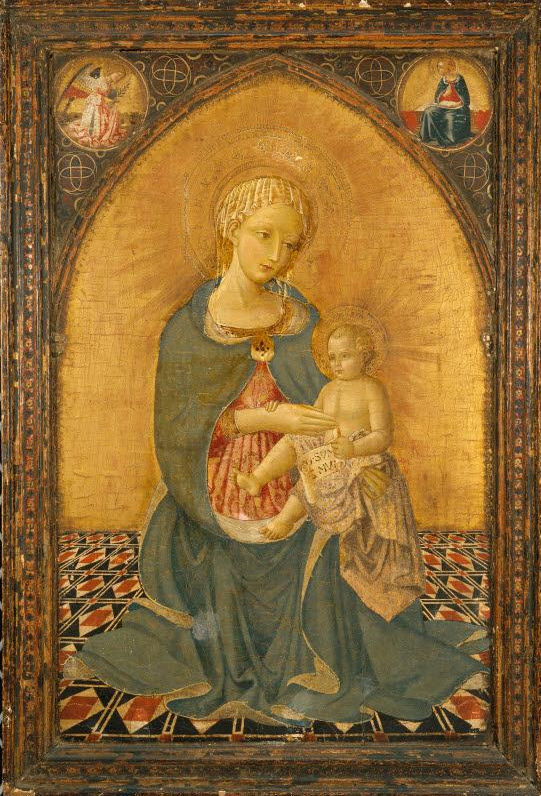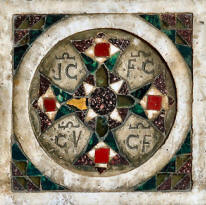Siena
April
2019
More
photos
here
|
Wednesday
3rd A trip with simple intentions this. I'm off to improve the many improvable entries on the pages devoted to Siena, the newest pages of The Churches of Florence, armed with prepared lists, possible opening times and a new camera. Earlier morning visits to some previously unvisited churches have been made more likely by my staying at a different hotel this time. I usually stay at the Palazzo Ravizza, but this year they have lost my custom. I emailed them to book a room, because I was told last time that this would benefit me as an old customer, but they quoted me a price a fair bit more expensive than if I'd just booked online. When I pointed this out they said I could have 10% off, which was still a bit more than online, but I said yes. They then wrote back demanding a €500 deposit by bank transfer and that I also have to provide some documentary proof that I'd paid. So this time I'm staying at the Hotel Chiusarelli which is over the other, north, side of town, but a bit more central, and nearer to the train station. It's also very near where one can catch the bus to Florence, if one wants to spend a day there catching up on the Verrocchio exhibition at the Palazzo Strozzi. As my easyJet flight was due to depart at a civilised 14.20 I had no need for any sleeping-at-the-airport-the-night- before rigmarole, and as it was midweek the possibility of engineering-works line-closures was low too. Fingers crossed. My train from Balham to East Croydon was 5 minutes late, but at East Croydon a Thameslink train to Gatwick left swiftly from the platform adjacent to the one I got off at, which was an unprecedented bonus. It stopped at 6 stations but I was in plenty of time. A small queue for bag drop, no queue for security and time enough for a Pret hot falafel and halloumi wrap and the long trek to gate 46 for another short queue and a take off on time! I can't remember the last time this was achieved by a flight I was on. Early arrival into Pisa, the quick arrival of the Pisamover, the catching of the train at Pisa Centrale that I'd identified as the likeliest one, and a smooth transfer at Empoli all conspired to see me passing through Poggibonsi with dusk falling, arriving in Siena at 8.14. Up the many escalators, through the Porta Camollia and I found my hotel with mapless ease. Room 13 overlooks the wide vista of the football ground behind (Robur Siena) and so no-one overlooks my window. Other things to like are the nice size of the room, the utter lack of cushions and notices/instructions/leaflets. The lighting permutations don't need an instruction manual, there's an old metal wall safe that opens clankily with a key, and the plug sockets also have USB charging sockets. I'm feeling good about the place already. Thursday 4th In fact I felt so good about the room last night that I stayed in it, as it was nearly 10.00 by the time I had unpacked, logged on to the WiFi and gathered my wits. So boy did I need my breakfast. There was long queue at the coffee machine as I made my entrance, due to a group, which soon left. Muesli, a cereali croissant and a slightly lighter and more biscuit-crumbly version of the usual apricot tart did well by my hunger, and the juice and coffee dispensing machines were a little slow but with good results. I headed south east, to try to find and visit a string of churches, lots of them dedicated to saints whose names begin with the letter G. Santa Maria di Provenzano, San Giorgio and Santo Spirito were all closed despite online info to the contrary, but I did find and photograph San Gaetano and San Giacinto, two oratories in the via dei Pispini that I expected to be closed, on the way to the Porta Pispini. In the same street I discovered Santa Chiara. I then made for Santa Maria dei Servi, partly to clear up a fresco reference, partly to actually get inside a flipping church and see some art. Both of these aims where happily achieved, with added Pietro Lorenzetti fresco attributions that I'd forgotten. So inspired, I thought I'd try to get over to San Francesco before it closed, but passing Santa Maria di Provenzano again I found it open! It's a church with more history than art (related to the Battle of Montaperti as it always is in Siena) but it was worth a look and it was good to get a new visit under my belt. It was well after 12.00 when I got to San Francesco, but it was 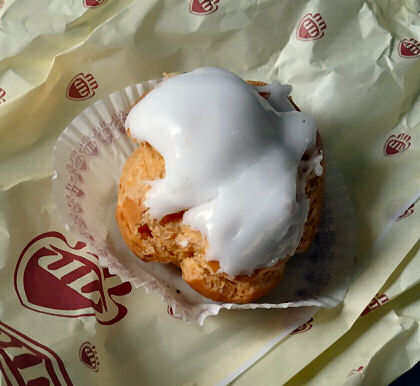 still open. I admired the Lorenzetti frescoes, in splendid isolation -
there had been no more than a couple of other people in all three of
this morning's visits - and found some handy light switches in all the
transept chapels. The threatening clouds between the sunshine this
morning started to leak as I headed back to the hotel. Nannini provided
a fine multicereali mozzarella and salad baguette, and a small
cake (see right). At a gelateria near the hotel I got a bottle of
mango flavoured iced green tea, and perused their gelato flavours,
which included carrot and almond, amaretto and cinnamon as well as
ginger and honey. I will surely return to sample.
still open. I admired the Lorenzetti frescoes, in splendid isolation -
there had been no more than a couple of other people in all three of
this morning's visits - and found some handy light switches in all the
transept chapels. The threatening clouds between the sunshine this
morning started to leak as I headed back to the hotel. Nannini provided
a fine multicereali mozzarella and salad baguette, and a small
cake (see right). At a gelateria near the hotel I got a bottle of
mango flavoured iced green tea, and perused their gelato flavours,
which included carrot and almond, amaretto and cinnamon as well as
ginger and honey. I will surely return to sample.After lunch in my room and doing my writing and photo-uploading thing I had my afternoon snooze, but from 4.00 it just kept raining harder, with thundering even. So more church research while I waited, but it didn't stop, so I started reading the novel reviewed below, and had a second night of the Nice Hotel Room Diet. Friday 5th There was some complex dawn-chorusing going on when I got up to answer nature's call in the early hours, and considerable church bells were blurrily perceived at 7.00 and 7.30. As I trotted downstairs the large group from yesterday were leaving, in a wheeling-suitcases way, so the breakfast room was lovely and empty. The muesli was followed by a cereali croissant with honey, and a chocolate croissant. Then another cereali, to use up the honey you see, and more coffee. Sometimes a linger is good for the soul - the churches can wait. To San Girolamo in Campansi first, accessed by asking the nice lady on reception in the care home in the convent attached - down the corridor and turn left basically. It turned our to be unobjectionably unshiny baroque. My route to Santa Maria in Portico a Fontegiusta took me past a  church marked on my map, in via del Pignatello, but unknown to me and
unlabelled on its door or walls. (I later found it to be called Maria
Santissima del Rosario). Santa Maria in Portico a Fontegiusta was open
if blindingly dark inside, as the internet and a Sienese blogger had
promised. Which was just as well as drizzle was in the air. The church
is worth a visit for some good art, including a Lippo Vanni Virgin and
Child fresco fragment over the high altar, covered in glass which
cunningly reflects the circular stained glass window over the door from
a certain angle (see right).
church marked on my map, in via del Pignatello, but unknown to me and
unlabelled on its door or walls. (I later found it to be called Maria
Santissima del Rosario). Santa Maria in Portico a Fontegiusta was open
if blindingly dark inside, as the internet and a Sienese blogger had
promised. Which was just as well as drizzle was in the air. The church
is worth a visit for some good art, including a Lippo Vanni Virgin and
Child fresco fragment over the high altar, covered in glass which
cunningly reflects the circular stained glass window over the door from
a certain angle (see right).Next up to the Osservanza, which is beyond the city walls, but looked walkable on my map, and it was, but would've been easier if the map hadn't lied, firstly about a road it said crossed the railway line, but it didn't, requiring some annoying backtracking, and then a road on the map turned out to be a steep footpath in real life, but one with fine views and rural peace. The Osservanza itself turned out to be a treat for the fan of gold-ground altarpieces, but too dark inside to do them justice. Back into town to Nannini for another mozzarella and tomato panino, but a round flat salty white one this time, and a marmalade doughnut thing. I indulged Some light guidebook book and tasteful notepad buying too. I only had a short post-lunch siesta, so was able to get out before 4.00 to get to San Bernardino and the Museo Diocesano with enough time to do them justice. Online it seemed that paying to visit San B and the MD on its own was not possible, and that you had to buy the Duomo Complex pass. This was true. But the place is a treat. The Sodoma and Beccafumi frescoes in the oratory are surprisingly impressive, and the gold-ground panels from closed or lost churches are a joy to get up close to. In the last of the four Museo rooms are a trio of Lorenzettis. As the evening was still young I trekked over to the vicinity of my previous hotel to find a new oratory or two. On the way I spotted a Misericordia ambulance, just as several stout men lifted a heavy plastic coffin in, supervised by a man in a suit with a clipboard. I ended up walking through the Porta Tufi, drawn to it by it being bathed in sunshine, and then the sight and smell of wisteria, followed by the sight of two chickens drew me further, then I caught site of the first Twingo this trip, and then I found the Monumental Cemetery of the Misericordia. Giving in to fate I went in and it was another Italian cemetery mind-blower - not quite as impressive as the one outside Bologna, but pretty close. The evening sun helped as did my having the whole monumental place to myself. Back through the gate I made for the pizza place opposite the Pinacoteca for a margherita slice that was as good as remembered, and then I noticed an A4 printed sign on the door of the Pinacoteca saying that it was currently temporarily closed for 'urgent works and extraordinary maintenance', and had been since the 17th of December 2018. Dammit! A sop is provided with the 'extraordinary opening' with free admission to the Palazzo Chigi Piccolomini at the Postierla on many days, and to the church of the Madonna delle Nevi, but just on Wednesdays. As the good gelateria I had discovered last time was very nearby I calmed myself with some coconut and pistachio, in a brioche! I ate it on the wall opposite the sun-bathed facade of the Duomo thinking that life is good. A thought confirmed by the purchase of a slice of cinnamon panforte on the way back to the hotel. I spotted several groups of people communicating with sign language through the evening, presumably members of a larger party, and noticed many signing into their phones. Technology! Saturday 6th Hoping that the large group of teenage girls that I saw getting checked in yesterday afternoon (Chelsea... Bella... Ashley...) would be having an early breakfast, I awoke to the reassuring sounds of guests already up and about, and by the time I abluted and got down to the breakfast room I had it almost to myself, and by the croissant course I was alone. Perfetto! To the freebie Palazzo Chigi Piccolomini learned about yesterday evening. Staffed by cheerful and helpful women of a certain age, and one grumpy man. They had no idea when the Pinacoteca was going to reopen. Through the door you go straight up to the first floor, where there are rooms full of unspecial 16th & 17th century art by the likes of Manetti and Mei, and a large hall frescoed with Old Testament scenes by Bernard van Rantwick. Up to the second floor for a more impressive hall, frescoed by the same artist with scenes from The Life of Scipio, and the like. And that's it. I'm glad it was free. Then to SM della Scala, where the ticket man sold me a concession ticket, assuming that I was over 65 I presume. Bastard. The special exhibition of Northern paintings really wasn't. It was called Una Città Ideale presumably as it included a painting of the Tower of Babel, which is just plain wrong. Nothing stood out from the rooms of studio of..., school of... and anonymous artists, nearly all of the works coming from the Siena Pinacoteca. Probably the most feeble exhibition ever to have had a sophisticated promo film made, with clever animations of the paintings and all. Still the SM della Scala complex is always a joy. The downstairs areas are a Labyrinth of Solitude, and that's no melodramatic exaggeration. You never know if the next corner or tunnel will reveal some frescoes, a chapel, a pit of bones, or maybe another living soul. On the ground floor the Old Sacristy now has glass cases full of reliquaries and at the back the big reliquary doors, painted by il Vecchietta for the cabinet which used to house them, are now nicely displayed. The creepy and stabby Massacre of the Innocents by Matteo di Giovanni has been moved to the big empty hall behind the Capella del Manto. To get my moneysworth out of the Duomo Complex ticket that I bought yesterday to get into San Bernardino I visited the Crypt and the Baptistery, both favourite spaces. I then did a looping walk around the back, almost as far as my old hotel, and back into the centre. At Nannini I got myself another mozza/tom cereali baguette and a marmalade turnover thing. My room looking out over the football stadium made me worried that a fixture might disturb my doze, it being Saturday, but although there was activity it seemed at first to be just training, with lines of those plastic dome things on the grass. But soon loud music was playing (Eye of the Tiger!) fans were filling the stands, and I had to close the window. A doze being impossible I set out for some church research early. Reasoning that given opening times are more likely to be observed on a Saturday, when more people would be about, I passed San Donato, San Giorgio and Santo Spirito again, but again without joy. Finding oratories and traces of lost churches had similarly mixed results, but the walking and exploring the medieval streets was fine in the sunshine. I encountered more packs of practicing palio drummers than you could wave a colourful contrada flag at, and the sound sure does carry. I did the thing where you look across the steep valley to where you're heading (Sant'Agostino) and then when you get there look back at where you were (SM dei Servi). The Misericordia hospital and its chapel was found, behind the ever-closed San Martino, and an unknown run-down contrada church called San Salvatore was discovered by accident. A slice of pizza was eaten at the usual place and the way back to the hotel found by yet another new route from the Campo, involving more direct-acrossness but also more steepness. Returning early I thought I'd give the bath a try. It was short, but so am I. |
|
|
|
|
||
|
Sunday 7th The quality of the croissants has kept me from sampling the pastries so far. They look like the standard sponge and tart selection, but this morning there was a strange sludge-coloured cheesecake. It turned out to be coffee flavour, so I went with the carrot-cake sponge. Not many people at breakfast, but a family group with two unhappy babies made me not linger. Today I had hopes of finding churches open for services that otherwise aren't. But first took a two-birds walk to the escalators that go to the railway station, for timing for Wednesday, and to check out Santa Petronilla nearby. It was open, empty, and had some nice paintings by many of the Nasini family and one of the Vanni, Raffaello, who seems to be haunting me this trip, and who here has a Death of Saint Joseph, an unusual subject, that plays to my sympathy for an under-appreciated and taken-for-granted chap. Back through the Porta Camollia, and following the via Francigena pilgrim's route. San Pietro alla Magione is always worth a visit and Sant'Andrea had a service on, and an altarpiece back that was missing last time. This church is open in the week so I'll return. But a bigger shock and buzz was big and central San Martino's open door - a sight unprecedented. A service was on, so only a quick photo, but I'll come back on my way back in the hope of it still being open. At the third attempt this trip San Giorgio and Santo Spirito were not open, of course, and so I hereby give up on them both forever. But I did finally find the fugitive remains of San Maurizio, after some luck searching online last night. Returning I found the little Misericordia chapel open and empty and did it justice. The service in San Martino next door was literally finishing as I entered, and everyone going in peace. I managed to write stuff and art-appreciate as the congregation shuffled out and bought raffle tickets. I had enough time, but had the impression I'd've been chucked out, along with some other gawkers, if I'd lingered. I was well pleased, though, to have seen inside one of my biggest unexplored. My usual baguette was bought for lunch, but I went back to a bakery I'd passed this morning and chose a a pilgrim's pane, with fruit salad and pistachio cream, realised that it was oddly expensive, then realised that what I'd chosen was a large crusty dark roll, now being freshly prepared with said filling. It was...interesting, and messy, and only half eaten. Later I decided to head out to the Misericordia cemetery again, as one of the huge halls had had a spiral staircase going down, which spoke of deeper things. And the old catacombs I discovered, some with huge round supporting columns and a dirt floor, made the walk there in the rain stunningly worthwhile. The low crypt-like spaces were also very Victorian railway-tunnel. It was just such a satisfyingly confusing maze of levels, with every space in the walls, floors and stairs used for all sizes and types of memorials. And all to myself. The rain stopped enough for me to scoff the usual pizza slice and then, having made a note of a poster, I remembered a promise that San Vigilio, attached to the university, would be open for a service tonight. And it was, and I was early enough to get a good wander, write and photo-take in beforehand. I celebrated two visits to rarely-open churches in one day with a gelato from the place with the wacky flavours - carrot and almond with amoretto and cinnamon. Yum! Monday 8th The breakfast room was again delightfully underpopulated and quiet this morning. I rang the changes by swapping my cereali croissant's accompaniment from honey to plum (prugne) jam. My list of website church finds and visits has mostly been dealt with. Saint Catherine's House is planned for this morning. The art in the Palazzo Chigi Saraceni was also on my list but I found out last night that it's guided tours only, presumably taking in the famous music-related parts too. There's only one tour a day, but if you want one in English it's a special prebooking. Pah! The Casa e Santuario di Santa Caterina is four churches on three levels, on the site of the family home of the Caterina Benincasa, who was the youngest of the twenty-five children of a dyer. The 14th-century Dominican who got the stigmata from a Crucifix in Pisa (on April 1st), successfully badgered Pope Gregory XI to come back from Avignon, was canonised by the Sienese Pope Pius II, was later made the patron saint of Italy, and later still of Europe. There is an actual baroque church, which has the aforementioned miraculous Crucifix, and two oratories, one converted from her bedroom, the other from the kitchen. The last one is the highlight space with a lovely polychrome majolica tile pavement and big art by Fungai, il Riccio and Sorri. The forth church is, in fact, the oratory of the local contrada on the lowest floor, it being the façade visible from the street, and a façade mystery cleared up by the nice man in the saintly shop. But it's not open to visitors. Off to San Pietro in Castelvecchio after, to see if the panels from the dismantled  polyptych by Ambrogio Lorenzetti which were restored for the big
exhibition last year are back, and they are, on the back wall left of
the high altar, in the modern framing made for the exhibition, but
unlabeled. Then down to Santa Lucia, by my hold hotel, to clear up a few
things, in the church and in the area. On the way back, aside from
lunch, I picked up some cavalucci biscuits, which I had just read
about, and which lived up to their promise to be chewy, with dried
fruit, honey and nuts, and spicy, like bread pudding crossed with
panforte and made into crunchy lumps (see right).
polyptych by Ambrogio Lorenzetti which were restored for the big
exhibition last year are back, and they are, on the back wall left of
the high altar, in the modern framing made for the exhibition, but
unlabeled. Then down to Santa Lucia, by my hold hotel, to clear up a few
things, in the church and in the area. On the way back, aside from
lunch, I picked up some cavalucci biscuits, which I had just read
about, and which lived up to their promise to be chewy, with dried
fruit, honey and nuts, and spicy, like bread pudding crossed with
panforte and made into crunchy lumps (see right). Some loud building /plumbing - type clanking kept me from dozing so I headed out around 4.00 to explore the Medici Fortress, which turned out to be as unpretty as I'd read, but with a certain run-down charm. And then walking up a slope I became aware of no small pain in my left calf, which was a new thing, and not a pleasant one. I circled the fortress slowly and then headed into San Domenico, for some muscle-relaxing (hopefully) shuffling around and writing. Over the road back to my hotel after to put up said leg and see what developed. But then reasoned that painkillers would be a good idea, and remembered vaguely a pharmacy opposite the gelateria with the interesting flavours. The nice man sold me some, called Momendol, and a bottle of water to wash the first one down. His saying that they should not be taken on an empty stomach decided me to go get a pizza slice, avoiding the more uppy-downy routes. But I soon realised that slopes give a chap an excuse for slow walking. After experiencing, and photographing, the peace of Siena on a weekday evening I came back via the just-mentioned gelateria, but it was closed! Tuesday 9th Less pain, but still pain this morning. Having few church needs remaining I decided to treat myself to the less-walking pleasures of the Palazzo Publicco. But first Sant'Andrea, which is very near to the hotel. I had time to linger as the Palazzo Publicco doesn't open until 10. 00. Sant'Andrea is lovely rough little church, even more of a draw for having its highlight gold-ground triptych back, shining out over the high altar, it's a Coronation of the Virgin with Saints Peter and Andrew by Giovanni di Paolo. A Romanesque feel, with odd fresco remainders adds to the appeal. As does wondering how one church can have two matching paintings, both by Apollonio Nasini, facing each other across the nave, of such obscure saints - Beata Aldobrandesca Ponsi and Sant'Alberto da Chiatina. The Palazzo Publicco I've been to twice before, but having a calf-saving slow visit to such a fresco-feast was a treat. A little waiting, or skipping ahead, was necessary to avoid the many school parties, but with patience comes admiration of the lesser gems, like Beccafumi's ceiling of the Hall of the Consistory, and the reward of five minutes alone in the Sala dei Nove with the Good and Bad Government frescoe. Twice. What with other bits by Ambrogio Lorenzetti, the room full of Spinello Aretino, the chapel full of Taddeo di Bartolo, and the hall with Simone Martini's Maesta facing the wall full of art-history arguments (see right), this is arguably the best €9 you can spend on looking at frescoes. Afterwards I headed around the back to Sant'Agostino, basically because it was less painful walking downhill, but when I got there I experimented with the unhopeful-looking route through the car park around the back of said church and was rewarded with a nice park-like walk with some spectacular views (see right). I got a mozza/salad panino in the Campo, and as it had been toasted and I was walking slowly I ate it on foot, so I could treat myself to an unusual gelato (ginger and honey/pear) what with it also suddenly being warm enough to unzip the jacket! My last evening walk took me to revisit, again, my new fave cemetery, the Misericordia. Reading my site entry for San Domenico I had realised that the huge statue of the Risen Christ erected in the crypt there in November 1938, to honour ten local 'fascist martyrs', and the similar statue in the Misericordia entrance, all mossy and corroded, were one and the same, with no plaque on it now to say so. A falafel in a padina was daintily scoffed on the bench by San Domenico facing over towards the sunlit side of the Duomo. And a vanilla and chocolate gelato in a brioche was taken too. Wednesday 10th No need to rush to Pisa as my flight was not until 18.10. Which was also to the good as the recent beginning of rare openings of Santa Maria delle Nevi are just on Wednesdays. The opening may be extraordinary, but the church is not. Barest church ever. It is good to see Matteo di Giovanni's Madonna della Neve altarpiece (usually now in the Pinacoteca) back in situ, but a light would have been nice. I then shuffled along to San Cristoforo to spruce up my entry and find a fresco that I'd read about since my last visit. Then some more major sprucing and clarification in San Domenico, including the finding in the shop of a cheap plush A4 book full of images of the very unlabelled paintings. The nice man in the station ticket office explained my route admirably, and also assured me that you still have to get your ticket date-stamped in the machine on the platform. The train I caught to get to Pisa, changing at Empoli, was the Florence train. I didn't realise you could catch a direct train between Siena and Florence, even if it does stop everywhere between Siena and Empoli, including Poggibonsi. The train I rushed to catch at Empoli was the one to La Spezia and it too did a fair amount of stopping. Early arrival at airport, I sat around and finished the novel reviewed below, bag dropped, ate a mozzarella, aubergine and salad cereali baguette, went through security and passport control, to the airy new waiting area, took off in good time and even arrived back at Gatwick early. After a long run of very delayed BA flights for me it's looking like the famous convergence of price and service between BA and easyJet is now evolving into easyJet winning. Germany in July is easyJet. We'll see. |
|
|
Trip
reading
|
J. F. Joni Affairs of
a Painter This is the autobiography of the Sienese restorer and forger who fooled Bernard Berenson, amongst other experts, the latter later realising and selling the Joni forgeries he'd bought, as originals. The pastiche pre-renaissance works that Joni produced where initially painted as such to cater to then-fashionable demand, only later where these in-the-style of panels sold as real old art. When, in the early 1930s, Joni revealed his plans to publish his life story some Italian dealers offered him much cash not to, but the book came out in 1932, with some names thinly veiled. When this English version was published in 1936, it had been cut in places. Its scarcity since is most likely down to Berenson's pal Joseph Duveen buying and destroying most of the copies. |
|
|
|
|
The copy I read was this 1936 edition, looking its age, from the London Library, but it'll set you back around £400 if you can find it online. It begins with Joni's childhood in Siena, spent with aunts and in a bastards' home, due to the suicide of his father just before his birth and his mother's consequent mental problems. All very harsh and interesting. From his childhood, dominated by contrada rivalries, we move to his apprenticeship and national service - all dominated by bravado, brawling and brief romances. He's mixed up with the politics of the time too. The language is oddly formal, but readable, and the detail often fascinating. The part that art plays in his life is constant, but even when he sets himself up on his own his work still doesn't overshadow the gossip, fights and loves. There is more art detail towards the end, though, with some self-excusing stress on the difference between semi-innocent signed pastiche - 'if you thought you were getting an original for that price you only have yourself to blame' - and outright forgeries. Amongst the last few chapters are Some Reflections on Connoisseurship and About the Preservation of Pictures. But this remains a book to be read more for human interest and social history than for insider art historical content. |
|
|
|
||
|
Hisham Matar A Month in Siena 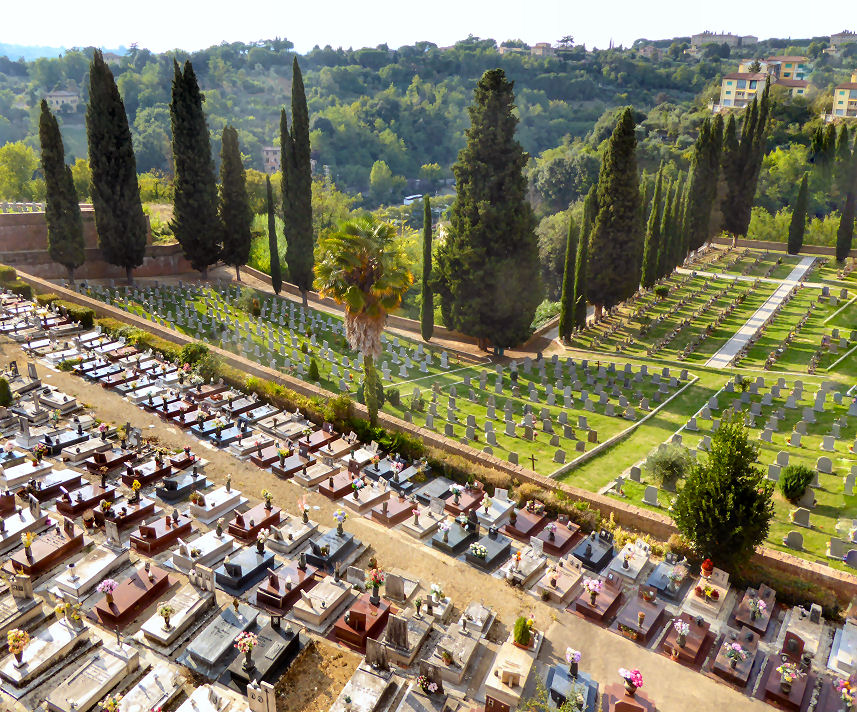 Death is a hefty presence here too, but the book could not be more different. The author is known for The Return, his book dealing with his post-Gaddafi return to Libya, to try to find out what happened to his father, who had been kidnapped and taken to prison there twenty-two years before. A Month in Siena is another memoir, but also a book about art. In it the author decides to indulge his life- long love of Sienese art by staying in Siena for a therapeutic month, following the publication of The Return, and to immerse himself in the art and city of Duccio and Lorenzetti. The result is a book full of humanity and art, and a particularly human vein of art writing. It's about the spending of time and the personal experience of paintings rather than, say, the dates and technical developments. He spends a lot of time in the Pinacoteca, and has wise words to say about gallery attendants. He makes it to San Bernardino too, and the overwhelming cemetery I visited on my 2016 Trip. A book combining warmth, humanity and an effortlessly strong flavour of the city itself. |
||
